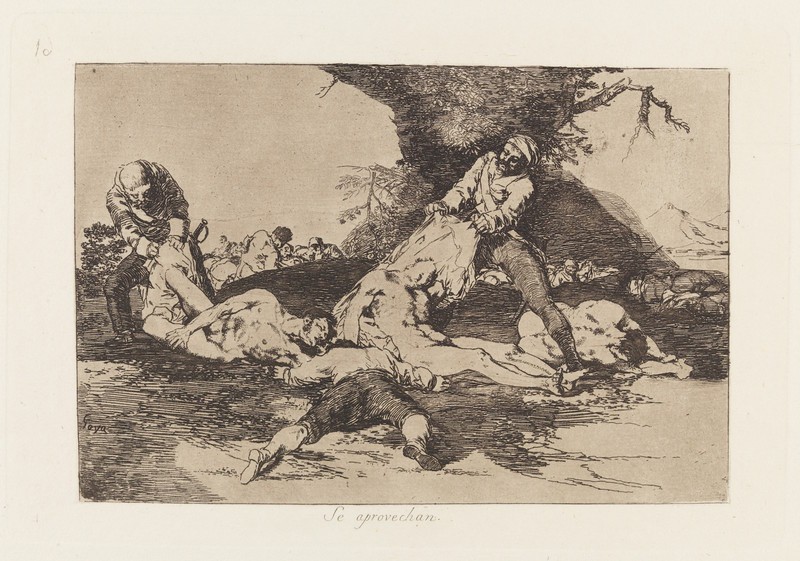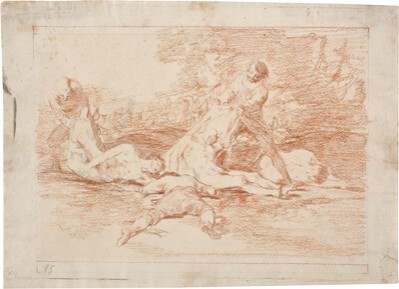- Cronología
- Ca. 1810 - 1812
- Dimensiones
- 162 x 237 mm
- Técnica y soporte
- Etching, aquatint, burin, drypoint and burnisher
- Reconocimiento de la autoría de Goya
- Undisputed work
- Ficha: realización/revisión
- 30 Nov 2010 / 02 Jun 2023
- Inventario
- 225
Goya (lower left-hand corner), 4 (lower left-hand corner of plate).
See Sad presentiments of what must come to pass.
The first state proof reveals traces of burin on the bald head of the man on the left-hand side and on the hair of the naked figure lying on his side in the centre. Before the addition of the lettering, burnished lavis has been used, burin has been used to do some retouching on the ground, and the signature has been added, just above the lower left-hand corner.
In the second state proof we can see how the etched lines on the ground have been burnished just above and below the legs of the figure being stripped of his shirt. Touches of burin have been used to strengthen the burnished etching lines.
The title was handwritten by Goya on the first and only print run that we know to have been made at the time, and which the painter gave to his friend Agustín Ceán Bermúdez. The title was engraved on to the copperplate at a later date, and no other modifications were made to the image for the first edition of the Disasters of War, which was printed by the Royal Academy of Fine Arts of San Fernando, Madrid, in 1863.
There is a preparatory drawing in the Prado Museum.
In the countryside, in broad daylight, two French soldiers are stripping the clothes from the dead bodies of some Spaniards recently killed in battle. In front of a large tree lies another, already stripped corpse and in the background, on the left-hand side, we can see two other figures, also perhaps engaged in this same task. Goya has skilfully depicted the anatomies of the corpses, which stand out thanks to the accuracy with which they are rendered and the brightness of the white paper showing through.
Situations of this type must have been relatively common during the war. It is the moment in which the fallen are plundered for their material belongings and, simultaneously, utterly deprived of their dignity. In this instance, just as we can see in other etchings in the series, the natural surroundings are inhospitable and arid. The tree placed in the centre of the composition has provided no shelter for the bodies of the fallen Spaniards, and its sharp, jagged shapes only serve to heighten the sensation of horror.
Enrique Lafuente Ferrari relates this etching to a number of others in the series, all featuring piles of dead bodies, such as no. 12, This is what you were born for, nº 18, Bury them and keep quiet, nº 21, It will be the same, no. 22, All this and more, no. 23, The same elsewhere, no. 27, Charity, no. 48, A cruel shame!, no. 62, The deathbeds and no. 63, A collection of dead men.
The etching plate is conserved in the National Chalcography Museum (cat. 267)
-
Goya. Das Zeitalter der Revolucionen. Kunst um 1800 (1980 – 1981)Hamburger KunsthalleHamburg1980cat. 239
-
Francisco de GoyaMuseo d'Arte ModernaLugano1996exhibition celebrated from September 22nd to November 17th.cat. 104
-
Francisco Goya. Sein leben im spiegel der graphik. Fuendetodos 1746-1828 Bordeaux. 1746-1996Galerie KornfeldBern1996from November 21st 1996 to January 1997cat. 16
-
Ydioma universal: Goya en la Biblioteca NacionalBiblioteca NacionalMadrid1996from September 19th to December 15th 1996cat. 211
-
Francisco Goya. Capricci, follie e disastri della guerraSan Donato Milanese2000Opere grafiche della Fondazione Antonio Mazzottacat. 96
-
Goya. Opera graficaPinacoteca del Castello di San GiorgioLegnano2006exhibition celebrated from December 16th 2006 to April 1st 2007p. 59
-
Goya et la modernitéPinacothèque de ParisParís2013from October 11st 2013 to March 16th 2014cat. 55
-
Goya, grabadorMadridBlass S.A.1918cat. 118
-
Goya engravings and lithographs, vol. I y II.OxfordBruno Cassirer1964cat. 136
-
Vie et ouvre de Francisco de GoyaParísOffice du livre1970cat. 1017
-
Catálogo de las estampas de Goya en la Biblioteca NacionalMadridMinisterio de Educación y Cultura, Biblioteca Nacional1996cat. 209
-
ParísPinacoteca de París2013p. 127
-
Goya. In the Norton Simon MuseumPasadenaNorton Simon Museum2016pp. 114-151

